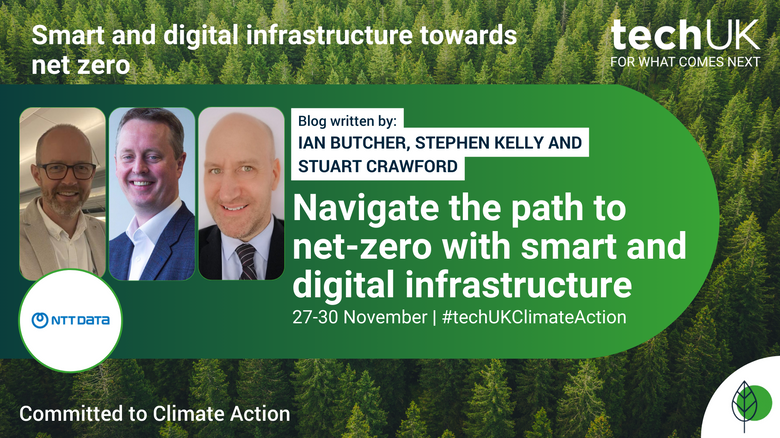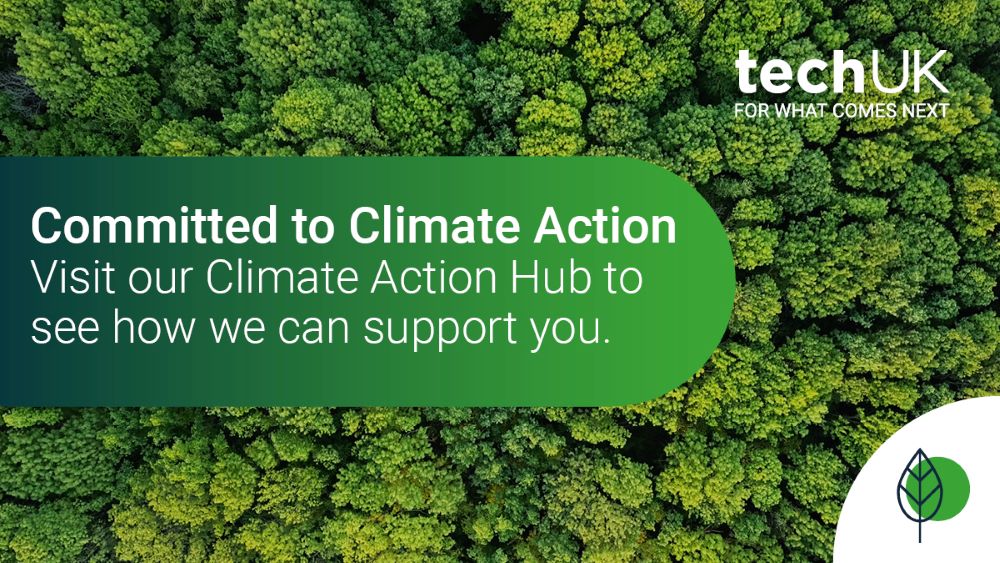Navigate the path to net-zero with smart and digital infrastructure (Guest blog from NTT Data)
Guest blog by NTT Data's: Ian Butcher, Senior Client Manager; Stephen Kelly, Vice President: Sustainability, Europe; Stuart Crawford, Senior Director, Sustainable Solutions & Partnerships. Part of techUK's Climate Action at COP28 Campaign Week 2023.

From intelligent buildings to data storage, organisations around the world are using technology to make a difference
As the number of climate-related natural disasters around the world rises rapidly, the goal of net-zero – balancing the amount of greenhouse gases emitted into the atmosphere and the amount removed from it – has taken on new urgency.
But how can organisations support this critical strategy to address the climate crisis and the challenges of global warming?
It’s an urgent consideration for both an organisation’s own long-term sustainability and the health of our planet – and smart and digital infrastructure is part of the solution.
Defining smart and digital infrastructure
Smart infrastructure is the integration of advanced technologies and digital solutions into physical infrastructure systems to enhance their performance, safety and sustainability.
This enables the collection and analysis of data that can be used to make real-time decisions and enable systems to adapt to changing conditions while reducing resource consumption.
Examples include smart transportation systems (such as intelligent traffic management), smart utility management and smart buildings – structures with integrated energy management, lighting and climate control systems that can adjust automatically based on occupancy and environmental conditions.
Digital infrastructure, on the other hand, refers to the foundational technology that enables the flow of data and supports various services and applications – in other words, the hardware, software and networks that make smart infrastructure possible.
For a leading IT infrastructure and services company like NTT DATA, with wide-ranging expertise in digital infrastructure, there are opportunities to use innovative technologies to help clients transform digitally and meet their sustainability goals.
Importantly, this means applying technology to support business goals and with a commitment to circularity and minimising environmental impact.
Embracing the circular economy in a digital world
Rethinking IT through the lens of the circular economy – an approach that aims to minimise waste and maximise the use of resources in a closed-loop system – is key to the adoption of smart technology. Digitalisation must not create more problems or contribute to environmental challenges.
To harness the power of smart technology effectively, organisations should design solutions that embrace circularity. This means considering the entire lifecycle of technology, from procurement and deployment to end-of-life. The equipment used should have a minimal carbon footprint and be recycled or repurposed responsibly.
This approach is also referred to as “sustainable IT”, as it focuses on reducing the environmental impact of the technology itself.
“IT for sustainability”, on the other hand, involves using technology to enable better outcomes, particularly in the context of environmental and business challenges. It helps organisations predict and manage a range of environmental events – for example, when city authorities need to anticipate and minimise the effects of flash flooding.
Walking the talk
For NTT DATA, leading by example through various initiatives and projects is pivotal. Our own sustainability targets include net-zero emissions across our operations by 2030 and across our value chain by 2040.
A noteworthy example is the ongoing implementation of smart-building capabilities, resulting in a 50% reduction in energy consumption in our offices in Cape Town, South Africa. And when we decided to consolidate our various work premises in Singapore, we used our own technology resources to design an intelligent workplace that would promote innovation and collaboration, making employees proud to return to the office.
Other projects include making the transition to renewable energy in our data centres and migrating our applications and data to more sustainable cloud environments.
Our sustainability ambitions and commitments create a powerful narrative: by sharing the challenges we face along the way and how we overcome them, we may inspire other organisations that are embarking on a similar journey towards sustainability.
We have made great strides, but we, our partners and our clients will only realise our sustainability ambitions through collaboration and the sharing of ideas.
Your journey towards net-zero
If your organisation wants to become more sustainable, where do you start?
- First, you need a clear road map. Our experts follow a structured approach that begins with understanding your organisation’s current state and the technology you use. A materiality assessment can help determine the environmental, social and governance impact of your technology and prioritise the next steps.
- Then comes the creation of decarbonisation plans, including benchmarking your progress for tracking purposes. It’s crucial to address all aspects of your organisation, including data centres, office spaces and employees’ commuting patterns. Here, intelligent workplace capabilities and the use of digital twins – virtual representations of your building systems that mirror their real-world counterparts in real time – come into play by providing the visibility to manage your IT estate effectively.
- Your sustainability strategy should also include combating data sprawl by assessing your data usage and optimising storage. Organisations are producing growing volumes of data, of which up to 60% is unused – with knock-on effects for storage-related energy use.
- Finally, to help you influence and change behaviour across your organisation and make a positive impact in the communities you serve, we emphasise volunteering programmes and other forms of awareness and skills training.
Are you ready?
The transition to net-zero is not an option – it’s a necessity. And while the path to net-zero is challenging, it’s one that every organisation must follow.
So, embrace the technology, embed circularity across your IT estate and make smart and digital infrastructure the driving force behind your transformation.
techUK - Committed to Climate Action
Visit our Climate Action Hub to learn more or to register for regular updates.
By 2030, digital technology can cut global emissions by 15%. Cloud computing, 5G, AI and IoT have the potential to support dramatic reductions in carbon emissions in sectors such as transport, agriculture, and manufacturing. techUK is working to foster the right policy framework and leadership so we can all play our part. For more information on how techUK can support you, please visit our Climate Action Hub and click ‘contact us’.





